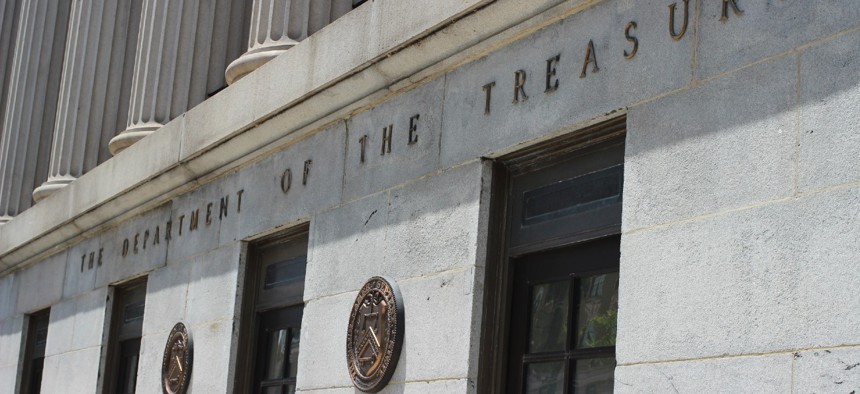
SammiStock / iStock.com
A Debt Default Could Mean Furloughs or IOUs for Federal Employees
There is a lot of uncertainty surrounding what would happen to agency operations and employees' compensation if the Treasury is unable to pay all of its bills.
The Senate on Wednesday is expected to vote on a standalone measure to raise the nation’s borrowing limit, though Republicans are expected to block the bill.
That would leave lawmakers less than two weeks until a default on the U.S. Treasury’s bills, an unprecedented situation that could create chaos for federal agencies and the U.S. economy in general. There is no blueprint for how the government would operate if it breaches its debt ceiling, though it is clear agencies would not be able to carry out their normal operations. Because typical spending outpaces the revenue the Treasury Department brings in on a given day, the federal government would only be able to pay 60% of its bills in a given month of a default scenario, according to a Bipartisan Policy Center estimate.
Analysts and Treasury officials have sketched out two possible outcomes during a default: the government would either delay payments until it collected enough revenue to cover them, or prioritize some payments while allowing others to go unpaid. Treasury officials told the department’s inspector general in 2012 that the prioritization option would be not just logistically difficult, but there would also be “no fair or sensible way to pick and choose among the many bills that come due every day.”
If a default period began on Oct. 18 as Treasury Secretary Janet Yellen has predicted would occur absent congressional action, the next pay day for most federal employees would be Oct. 29. Agencies do not have detailed contingency plans for a default scenario as they do for an appropriations lapse, and their ability to pay their workers could depend on how Treasury opts to prioritize payments. Federal employees could face furloughs, though unlike during a shutdown, agencies would not be prohibited from obligating funds. Some scholars have suggested the government could ask employees to continue working and simply give them “IOUs” until the debt limit was addressed.
“Failing to raise the debt ceiling would not bring the government to a screeching halt the way that not passing appropriations bills would,” the Congressional Budget Office said in a 1995 report. “Employees would not be sent home, and checks would continue to be issued. If the Treasury was low on cash, however, there could be delays in honoring checks and disruptions in the normal flow of government services.”
Essentially, CBO said federal agencies could continue to conduct their business without actually sending out payments for debts accrued. In the “delay” scenario, Treasury would wait the requisite number of days to collect the funds it would need to pay the debts accrued on the first day of a default. That process would continue until it had enough funds to pay the second day’s bills, and so on. Treasury officials told the IG that option would be the most feasible.
Rachel Snyderman, associate director for economic policy at the Bipartisan Policy Center, said such a scenario would “challenge the relationships” agencies have with beneficiaries, states, grantees, contractors and, potentially, their own employees. An analysis by the policy center found if Treasury opted to delay payments while in default, the Oct. 29 pay day would likely be pushed back until Nov. 8.
“Agencies wouldn’t be able to say when payments are going out,” Snyderman said.
The Congressional Research Service said in a 2015 report that such an approach would force those entities to bear the costs of default.
“A government that delays paying its obligations in effect borrows from vendors, contractors, beneficiaries, other governments, or employees who are not paid on time,” CRS wrote.
Some have questioned whether Treasury has the legal authority to prioritize certain payments over others, though the Obama administration at least discussed the possibility with the Federal Reserve during a near-default in 2011. During that planning, the department discussed making principal and interest payments on existing debt and delaying other obligations—such as payments to agencies and Social Security beneficiaries—until it had enough cash to meet a full day’s bills. A Treasury official told lawmakers in 2014 the department would be technologically capable of prioritizing principal and interest payments on debt while not paying other bills, but said the approach would be "experimental" and create "unacceptable risk" to financial markets.
Snyderman said it remains “quite unclear” whether federal salaries would be prioritized if Treasury went that route. Those tasked with administering their agencies’ budgets would also face “tremendous uncertainty,” she added. A recent Brookings Institution report similarly said federal employees and contractors in that scenario “would face uncertainty about how long their payments would be delayed.”
Federal contractors, too, could face an IOU instead of payment.
“We may very well have federal contracts, the federal government may ask those contractors to keep working and say ‘the check’s in the mail’ or they may say we have to stop this contract until we have the money to pay you,” said Mark Goldwein, senior vice president and senior policy director for the Committee for a Responsible Federal Budget.
Senate Minority Leader Mitch McConnell, R-Ky., and his colleagues have pushed Democrats to raise or suspend the debt ceiling through a budget process called reconciliation, which would allow the majority party to move the legislation without any Republican support. Senate Majority Leader Chuck Schumer, D-N.Y., has so far called that proposal a non-starter. He has called on Republicans to stop filibustering the House-backed standalone bill and allow Democrats to pass it on their own through a regular vote. Neither side has indicated it is willing to budge.
Courtney Bublé contributed to this report.







